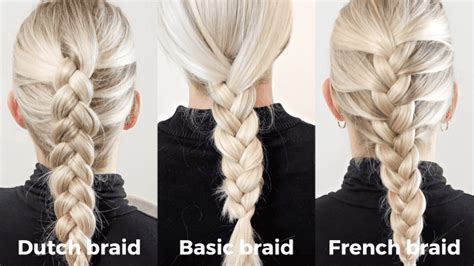Introduction
The world of hair braiding boasts two iconic techniques that have captivated hairstylists and fashion enthusiasts alike: Dutch braids and French braids. Both styles exude elegance and versatility, offering countless possibilities for intricate updos and everyday hairstyles. But behind their superficial similarities lies a fundamental difference in technique and appearance that sets them apart. This comprehensive guide will delve into the intricate details of Dutch braids and French braids, empowering you with the knowledge to choose the perfect style for any occasion.

Dutch Braid: The Inverted Masterpiece
Key Features:
- Also known as an “inside-out” braid
- Strands are crossed over each other and then under the central strand
- Creates a raised, voluminous effect
Step-by-Step Guide:
- Divide your hair into three equal strands.
- Hold the right strand over the central strand and under the left strand.
- Repeat step 2 with the left strand, bringing it over the central strand.
- Continue alternating and gradually adding hair from the sides.
- Secure the end with an elastic band.
Why It Matters:
- Adds instant volume and texture to the hair
- Suitable for fine or flat hair types
- Ideal for creating dramatic updos and formal hairstyles
French Braid: The Classic French Touch
Key Features:
- Strands are crossed over each other and then over the central strand
- Creates a more subtle, interwoven effect
Step-by-Step Guide:
- Divide your hair into three equal strands.
- Hold the right strand over the central strand and then over the left strand.
- Repeat step 2 with the left strand, bringing it over the central strand.
- Continue alternating and gradually adding hair from the sides.
- Secure the end with an elastic band.
Why It Matters:
- Provides a more polished and intricate look
- Ideal for all hair types and lengths
- Versatile for both everyday and special occasions
- Can help to tame frizz and flyaways
Comparison Table: Dutch Braid vs. French Braid
| Feature | Dutch Braid | French Braid |
|---|---|---|
| Weaving Technique | Strands crossed over and then under | Strands crossed over and then over |
| Effect | Raised, voluminous | Subtle, interwoven |
| Volume | Adds volume | Preserves volume |
| Hairstyles | Formal updos, dramatic styles | Everyday hairstyles, intricate buns |
| Hair Types | Fine and flat | All hair types |
Benefits of Dutch and French Braids
Both Dutch braids and French braids offer a multitude of benefits, making them popular choices for hairstyling enthusiasts.
- Versatility: Both styles can be adapted to suit various hair lengths and textures, from sleek ponytails to voluminous buns.
- Time-Saving: They are relatively easy to learn and can be completed in a matter of minutes, making them ideal for busy individuals.
- Protective: Braiding can help to protect hair from damage by reducing friction and tangling.
- Styling Flexibility: Dutch and French braids can be incorporated into countless hairstyles, from casual braids to elegant updos.
Customer Testimonials
“Dutch braids have been a lifesaver for my fine hair. They instantly add volume and make my hair look so much thicker.” – Sarah, a satisfied customer
“I love the intricate look of French braids. They’re perfect for special occasions or when I want to dress up my everyday hairstyle.” – Emily, a regular French braid user
Conclusion
Dutch braids and French braids represent two distinct and captivating hair braiding techniques. While Dutch braids offer dramatic volume and an inverted effect, French braids exude a more subtle and intricate charm. Whether you prefer a statement-making updo or a timeless everyday hairstyle, understanding the differences between these two styles will empower you to make an informed choice and achieve your desired look.
